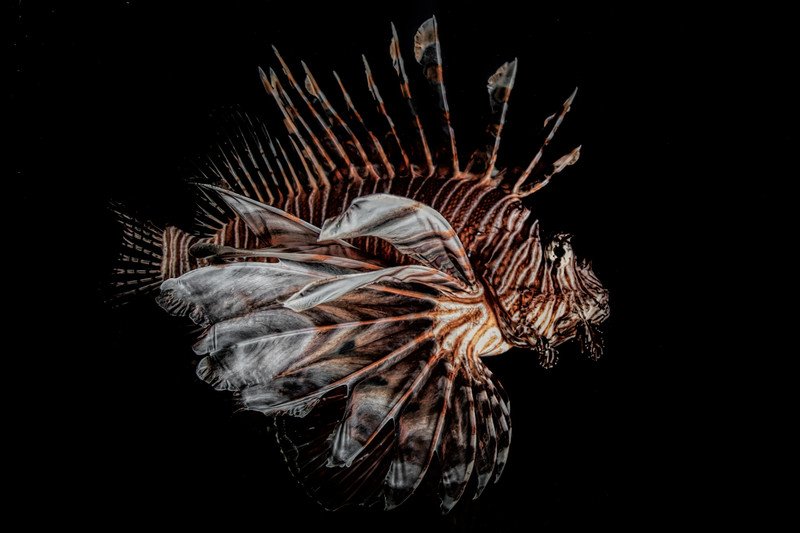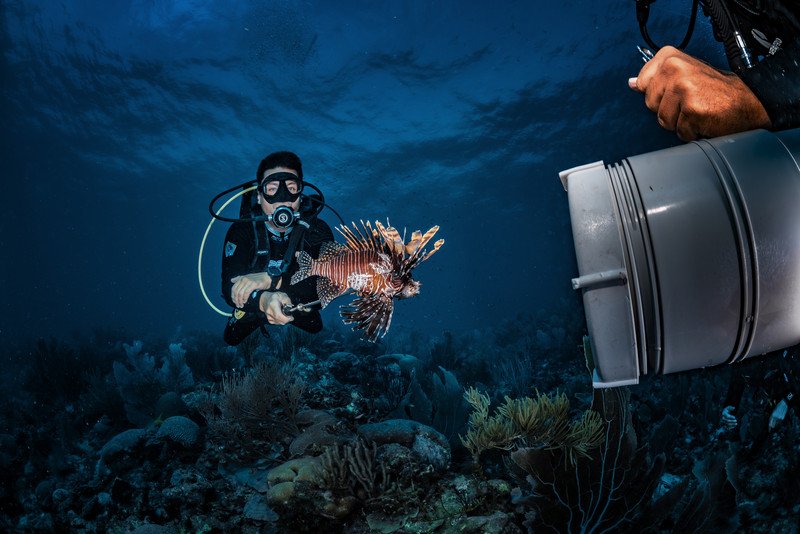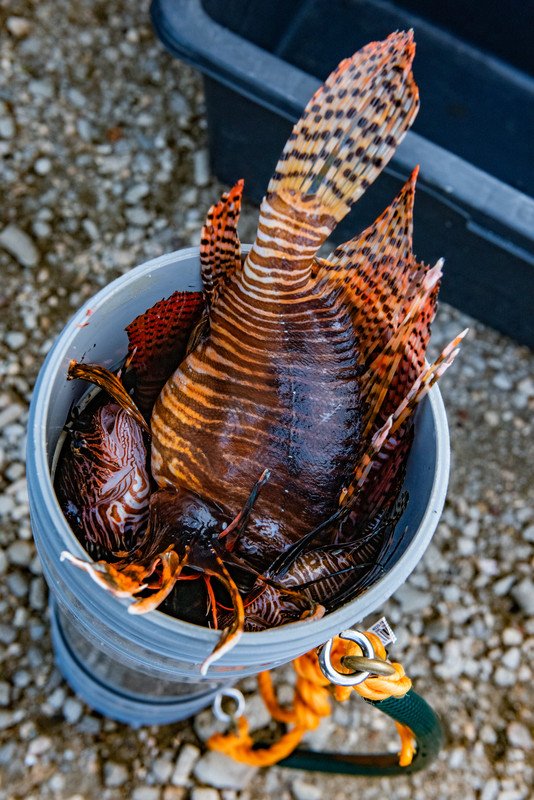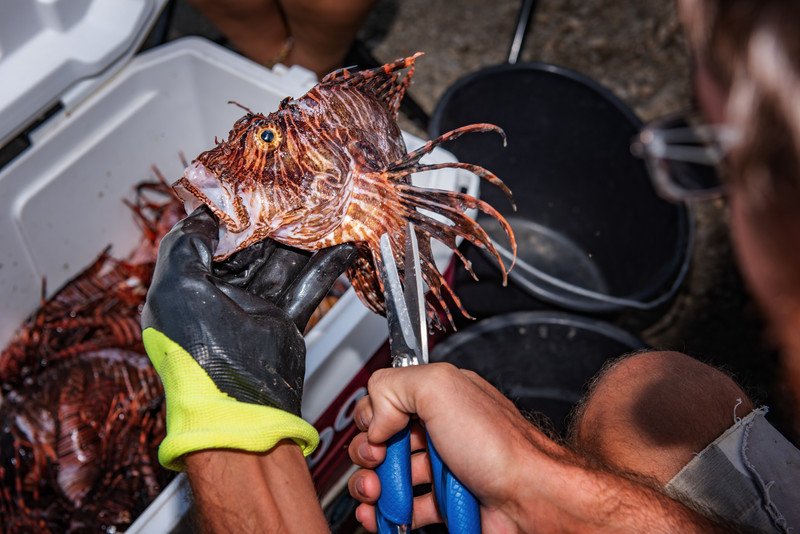Lionfish
© Lorenzo MittigaINVASIVE LIONFISH AND THE EFFORT FOR ITS ERADICATION: DIVER HUNTERS
Lionfish are native to the Indo-Pacific but are now established along the southeast coast of the U.S., the Caribbean, and in parts of the Gulf of Mexico.
The invasion may be one of the greatest threats of this century to warm temperate and tropical Atlantic reefs and associated habitats.
The Indo-Pacific red lionfish (Pterois volitans) is a venomous, voracious predator characterised by reddish-brown striped bodies, large ornate pectoral fins and fleshy tentacle outgrowths above their eyes. They bring true meaning to the term ‘generalist’ as they live anywhere from 1 – 300m in the coral reef, mangrove, seagrass and estuarine habitats. Their generalist diet also extends to their diet as they pretty much eat anything that would fit in its mouth, ranging from small fish, shrimp, crab, lobster and even octopus and stingrays!
Their reproductive output is remarkable; as they can release about 20,000 eggs every 4 or 5 days. This coupled with the lack of natural enemies and the naivety of native prey to their many feeding strategies contribute to lionfish’s success and makes them one of the worst marine invaders of all time.
Lionfish cause the majority of their impact based on what they eat. Thus my research has focused on monitoring their diet and how it changes over time in order to predict their impacts, i.e. how will local industries and ecosystems be affected based on the proportion of commercially and ecologically important species being consumed.

How did the Lionfish get to the Atlantic?
While the exact cause is unknown, it's likely that humans provided a “helping hand”. Experts speculate on a few theories: that people have been dumping unwanted lionfish from home aquariums into the Atlantic Ocean for up to 25 years; that lionfish were accidentally released from public aquariums after they were destroyed by hurricanes; or involuntarily transported as larvae in the container’s ship ballasts loaded in the Indian Pacific and then released in the Atlantic.
Since lionfish have a very strong capability of adapting to a wide temperature’s range, they had survived in the temperate waters of the US Atlantic coasts and widely reproduced. But one of the greatest reasons for lionfish spreading is that, since they are not native to Atlantic waters, they have very few predators. They are carnivores that feed on small crustaceans and fish, including the young of important commercial fish species such as snapper and grouper.
Unfortunately, specialized researchers have concluded that invasive lionfish populations will continue to grow and cannot be eliminated using conventional methods. Marine invaders are nearly impossible to eradicate once established.
How lionfish will affect native fish populations and commercial fishing industries has yet to be determined. What is known is that non-native species can dramatically affect native ecosystems and local fishing economies. Experts are carefully studying these invaders to better understand their role in, and potential threat to, Atlantic Ocean ecosystems.
Lionfish have venomous spines that can be very painful. Scientists are also actively studying these fish to better understand the potential threat that lionfish pose to the key reef and commercial fish species.



Lionfish arrived on Bonaire
So what is being done in Bonaire to tackle this problem?
Throughout the Caribbean region, numerous lionfish control and management strategies have been initiated as a means to quell the future spread and growth of the lionfish population, but they all vary in their success rates. Bonaire has one of the most effective and successful lionfish management strategies; which is due to the involvement of dedicated volunteer lionfish hunters and partnerships with the nature governing agency (STINAPA Bonaire); and local dive shops.
The most effective would be through divers because that means there is no by-catch. However, using divers means there is a depth limit to which they can go. So the tool you use [to tackle the lionfish] depends on the country you are working in and the people doing the removal. Where lionfish are found at great depth you need traps that are most effective. In shallow waters 14 metres and above you find divers are most effective.
Before the lionfish arrived along the coasts of Bonaire, they were already spreading fast along the southeast US Atlantic coasts to the Caribbean islands and a control plan began with informative workshops involving the Bonarian government and the dive industry in April 2009.
The first lionfish was sighted and collected on October 26, 2009.
The STINAPA Bonaire Marine Park immediately activated the second phase of the control plan. With the arrival of lionfish, the dive centers began giving divers information during the BNMP orientation. Divers were given markers with which to mark the location of lionfish and would then alert the BNMP. At that time BNMP staff would remove the lionfish using nets.
Near the end of 2009, the BNMP began training volunteers in lionfish removal techniques. BNMP rangers held more than 40 training workshops.
In the beginning, volunteers within the tourists and local divers were trained to spot, mark and report lionfish and all the information were uploaded to the “death row” database. A dedicated staff was trained to coordinate the program.
Given the new situation, Spearfishing legislation changed in September 2010:
“ARTICLES CONCERNING FISHING”
Article 9
1. It is forbidden to use mechanical gear, explosives, hand spears or poles with hooks, to hunt or catch marine life.
6. With the exception of explosives, the prohibitions set forth in paragraph .... do not apply to the Manager or to the persons assigned by the Manager, upon catching, gathering and killing of harmful species ..... of the Island Resolution Nature Management Bonaire”.




Eradicate Lion Fish Tool (ELF)
In Bonaire, it is a marine park and there is a ban on spears so there is only the Eradicate Lionfish Tool that you can use there.
More than 300 mechanical Eradicate Lion Fish Tool (ELF) were distributed. The ELF tool was developed by divers who were concerned with the damage that alternative Lionfish hunting devices such as traditional spear guns and nets do to the reefs.
So the tool you use [to tackle the lionfish] depends on the country you are working in and the people doing the removal. Where lionfish are found at great depth you need traps that are most effective. In shallow waters 14 metres and above you find divers are most effective.
A mandatory training course was held by BNMP staff to teach volunteers divers how to properly use the ELF reducing the impact of hunting on the reef. Rule number one was “do not shoot if you are not sure to kill the lionfish with a clean shot”. In fact, lionfish learn from experience. If the shooter misses a lionfish, it will be harder to catch it later. The lionfish easily associate divers to hunters and while years ago they were relatively easy catches, now are more difficult to get speared hiding in the coral reef’s cracks.
The dive centers were involved and began teaching the “lionfish hunter” course to tourists and locals. The locals may apply to use an ELF from STINAPA after completing the mandatory training course. Tourists are allowed to use ELFs after completing a course with a local dive center and only with a local guide.
The hunters
Within Bonaire, the “hunters” tend to be people that are a little bit older because they have the time to do this or people who are diving enthusiasts. Forty per cent have been Americans. They are not necessarily diving professionals but they have considerable diving experience, as much as between 500 to 2000 hours of diving.
The impact of lionfish hunters is considerable. The thing about using pure numbers is that this will only be in terms of where you can see. In Bonaire in 2010, you would see lionfish in high numbers. In a single one-hour dive there would be 30 to 40 lionfish. Now you are lucky to even see one. It is not known if they have gone much deeper. There were reports by divers on submarines going down to 300 metres that they are seeing lionfish there. It is seeing a difference in the shallow waters but it’s not known if the hunting actually reduced the population or just caused them to go deeper.

The Zookeeper
At the beginning of the lionfish eradication program, the hunters were still using a “wet bag” to store the caught lionfish. While catching a lionfish is relatively easy, to remove it from the spear and carry it without getting hurt by the venomous spines is quite difficult and dangerous. So, an immediate alternative to the bag was on the top of the “to do” list for this
program. After different devices were tried unsuccessfully (baskets, clear dry bags etc) The Lionfish hunters began using the so-called “zookeepers” and similar devices. The zookeeper is a PVC pipe closed at one end and with a modified plastic funnel on the other end. Once the LF is speared on the ELF, it can be removed easily from the tip only by inserting the ELF with LF into the funnel and then pulling out the ELF again, the venomous fish remains in the hard PVC pipe (container) with no chances to puncture it through and harm the diver. At the same time, the fish cannot go out because of the funnel.
Even if being accidentally punctured by the lionfish venomous spines (not all its spines are venomous) could happen, the probability is very low and it happens only by bad handling of the fish by the hunter.
To avoid the painful reaction of a lionfish’s venomous spine, some basic rules should be respected at all times when handling this fish: use always the zookeeper; do not touch a live speared lionfish; do not kill it with a knife; do not trust gloves. Another inconvenience when hunting lionfish is the presence of predators like sharks and morays. The irresponsible behaviour of some hunters, by offering dead lionfish to predators, made these ones more inquisitive and dangerous for the divers. Predators could easily associate the divers with the presence of easy food and get aggressive. It happens in certain dive spots that divers, hunters or not, are chased by moray or attract sharks.
The majority of calls made to hospitals about lionfish involve stings. Although lionfish stings are very painful, most can be managed at home if the pain is controlled and tetanus immunization is up to date. Symptoms following lionfish stings develop within minutes to a few hours and can include swelling, tenderness, warm skin directly surrounding the sting site, redness, sweating, muscle weakness, and a tingling sensation. A lionfish sting involving multiple spines increases the risk of infection and body-wide symptoms such as changes in heart rate, abdominal pain, sweating, and fainting. Deaths from lionfish stings are rare. Symptoms can last anywhere from 8 hours to 30 days depending on the severity of the sting.




Nothing goes wasted
At the present situation, with more than a decade of experience in managing the lionfish program on Bonaire, dive centers offer lionfish hunter courses which are part of the “most liked” from tourist divers that come on the island mainly to hunt lionfish. For a small island as Bonaire, with scuba diving as the main reason and activity of its tourists to come, the involvement of so many hunters, is reducing drastically the numbers of the lionfish, helping to protect the local reefs and their creatures. Something that is not happening in many other islands where the diving industry is less present and not coordinated with the marine park authorities.
But what happens to the catches? Well, it was immediately discovered that due to the fact that the lionfish are venomous but not poisonous (only some spines have a toxin but not the flesh), the dangerous spines can be easily removed during the cleaning and the fish can be filleted and eaten in various ways, from ceviche to fried. Because of that, since a few years on Bonaire, it did start a side business around lionfish eradication. Instead, to throw away the catches, they started to be offered and sold to a local restaurant that became pretty specialized in lionfish dishes. Some local divers round off the salary by regularly hunting and selling lionfish to local restaurants that offer LF on the menu. The largest restaurant bought 967 kg of LF in one year (2014) and 150 kg (2018), this states that lionfish have been reduced drastically. Still, most of the LF caught are brought home for consumption and not reported.
In the end, the best way would be to develop markets for the end-users of lionfish as a slice of meat, using it to make jewellery—some local people developed a line of neckless and earrings that are using the lionfish spine—and developing a market for all sizes of lionfish. The large lionfish are plate fish, small lionfish can be used as sausages or deep-fried. You can use the spines to make toothpicks and use the head and bones to make a stock for soup. Creating monetary value from the lionfish would encourage people to remove it from our waters.


Today on Bonaire
Active volunteers are permitted to hunt everywhere except in the reserves. Every day there are at least 10 to 20 divers active in hunting lionfish on the island. To maintain a low density of LF and keep the volunteers enthusiastic, the BNMP periodically opens the dive reserves exclusively for lionfish hunters calling this event “Lionfish derby”.
12 Lionfish hunters removed a total of 302 lionfish in a three-hour dive during this 2021year competition. Bonaire LF hunters have been controlling the population. However, there are areas not accessible to hunters all the time.
Keeping Monitoring the situation
Every year BPNM does the LF Density survey. Marine biologists, during 10 days, set transect of 50m length along the reef at 24 dive sites. The transects are placed 35, 25, and 15m depths. From the obtained results, it has been seen that Bonaire lionfish hunters have been doing a great job in lionfish control and that overfishing works very in Bonaire in order to keep the lionfish population’s density stable in low numbers since the first sighting. Open communication with the dive industry and volunteers is the best way to control lionfish.
click to view the complete set of images in the archive
